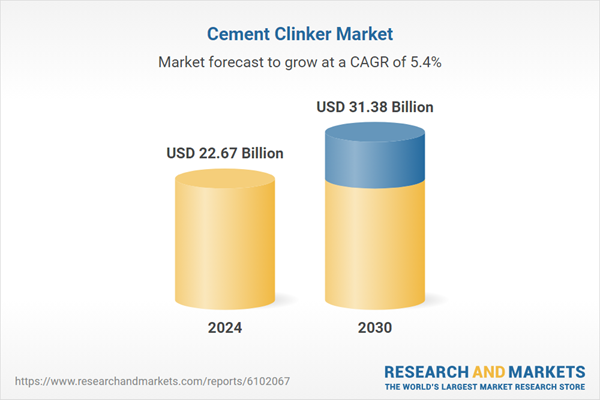Free Webex Call
The Cement Clinker Market was valued at USD 22.67 Billion in 2024, and is expected to reach USD 31.38 Billion by 2030, rising at a CAGR of 5.41%. Cement clinker, a key intermediate in Portland cement production, is formed by sintering a mixture of limestone, clay, and other raw materials in high-temperature kilns. Once cooled, clinker is ground with gypsum to produce cement. The market is integral to the global construction industry, with cement being a foundational material in residential, commercial, and infrastructure projects. Rapid infrastructure expansion, especially in emerging markets, along with ongoing urban development and real estate activity worldwide, is driving consistent demand for cement clinker across applications ranging from highways and railways to housing and industrial facilities. Speak directly to the analyst to clarify any post sales queries you may have.
10% Free customizationThis report comes with 10% free customization, enabling you to add data that meets your specific business needs.
Key Market Drivers
Global Infrastructure and Urbanization Surge
The rapid expansion of infrastructure and urban development across both developed and developing economies is a primary driver of the cement clinker market. Emerging nations in Asia-Pacific, Africa, and Latin America are investing heavily in public works, affordable housing, and smart city projects, all of which require large volumes of cement. Cement clinker, being the essential precursor to cement, sees rising demand in tandem with these construction activities. Programs such as India’s “Gati Shakti” and China’s Belt and Road Initiative continue to stimulate long-term clinker consumption. Simultaneously, developed economies are undertaking modernization of transport systems, utilities, and buildings, further supporting clinker usage in both new construction and renovation efforts.Key Market Challenges
Environmental Impact and Regulatory Pressure
Cement clinker production is among the most carbon-intensive industrial processes, with significant CO₂ emissions resulting from both fuel combustion and limestone calcination. As environmental regulations tighten globally, clinker producers face mounting pressure to adopt cleaner technologies. Compliance with emissions standards often necessitates investment in carbon capture systems, use of alternative fuels, and improvements in kiln efficiency - all of which increase operational costs. In regions with stringent climate policies, smaller producers may struggle to remain competitive. Additionally, the regulatory landscape in emerging markets may be inconsistent, leading to uncertainty in capital planning and delays in sustainability-oriented upgrades.Key Market Trends
Shift Toward Low-Carbon and Sustainable Cement Clinker Production
Growing emphasis on reducing carbon emissions in the construction industry is leading to innovations in low-carbon clinker production. Manufacturers are exploring supplementary cementitious materials (SCMs), such as fly ash and slag, to reduce clinker content in blended cements. Technologies like carbon capture and utilization (CCU), along with alternative kiln fuels including biomass and refuse-derived fuels, are also gaining traction. These trends are supported by green building certifications, investor focus on ESG compliance, and government incentives for sustainable industrial practices. As a result, the industry is gradually transitioning toward environmentally responsible clinker manufacturing processes.Key Market Players
- LafargeHolcim Ltd.
- HeidelbergCement AG
- CEMEX S.A.B. de C.V.
- UltraTech Cement Ltd.
- China National Building Material Company Limited (CNBM)
- Shree Cement Ltd.
- Asia Cement Corporation
- Taiheiyo Cement Corporation
- Dangote Cement Plc
- JK Cement Ltd.
Report Scope:
In this report, the Global Cement Clinker Market has been segmented into the following categories, in addition to the industry trends which have also been detailed below:Cement Clinker Market, By Type:
- Ordinary Portland Cement (OPC)
- Blended Cement
Cement Clinker Market, By Distribution Channel:
- Direct Sales
- Distributors/Wholesalers
- Online Sales
Cement Clinker Market, By Application:
- Residential
- Commercial
- Infrastructure
Cement Clinker Market, By Region:
- North America
- United States
- Canada
- Mexico
- Europe
- France
- United Kingdom
- Italy
- Germany
- Spain
- Asia-Pacific
- China
- India
- Japan
- Australia
- South Korea
- South America
- Brazil
- Argentina
- Colombia
- Middle East & Africa
- South Africa
- Saudi Arabia
- UAE
- Kuwait
- Turkey
Competitive Landscape
Company Profiles: Detailed analysis of the major companies present in the Global Cement Clinker Market.Available Customizations:
With the given market data, the publisher offers customizations according to a company's specific needs. The following customization options are available for the report.Company Information
- Detailed analysis and profiling of additional Market players (up to five).
This product will be delivered within 1-3 business days.
Table of Contents
1. Product Overview
2. Research Methodology
3. Executive Summary
5. Global Cement Clinker Market Outlook
6. North America Cement Clinker Market Outlook
7. Europe Cement Clinker Market Outlook
8. Asia-Pacific Cement Clinker Market Outlook
9. South America Cement Clinker Market Outlook
10. Middle East and Africa Cement Clinker Market Outlook
11. Market Dynamics
12. Market Trends & Developments
13. Company Profiles
Companies Mentioned
- LafargeHolcim Ltd.
- HeidelbergCement AG
- CEMEX S.A.B. de C.V.
- UltraTech Cement Ltd.
- China National Building Material Company Limited (CNBM)
- Shree Cement Ltd.
- Asia Cement Corporation
- Taiheiyo Cement Corporation
- Dangote Cement Plc
- JK Cement Ltd.
Table Information
| Report Attribute | Details |
|---|---|
| No. of Pages | 180 |
| Published | June 2025 |
| Forecast Period | 2024 - 2030 |
| Estimated Market Value ( USD | $ 22.67 Billion |
| Forecasted Market Value ( USD | $ 31.38 Billion |
| Compound Annual Growth Rate | 5.4% |
| Regions Covered | Global |
| No. of Companies Mentioned | 10 |









